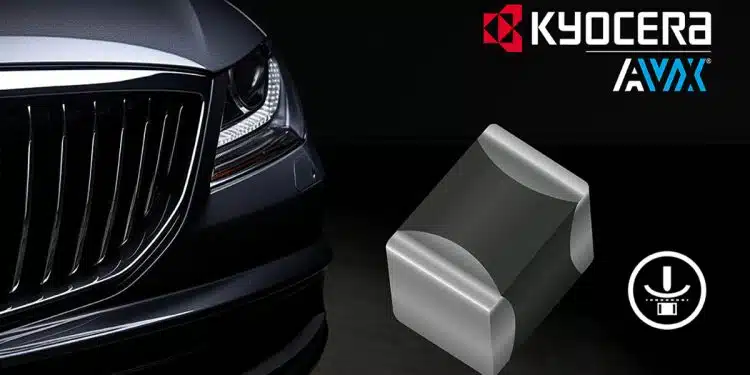KYOCERA AVX, a leading global manufacturer of advanced electronic components engineered to accelerate technological innovation and build a better future, is proud to announce that several VCAS Series multilayer varistors (MLVs) are now qualified to both the VW80808 and AEC-Q200 standards.
The new VW80808 qualification further ensures optimal performance in an extended range of demanding, high-reliability applications in the automotive industry and beyond.
VCAS Series MLVs, introduced in October of 2022, were the industry’s first MLVs equipped with automotive-grade flexible terminations, and several parts in the series are now the first flexible-termination varistors to be qualified to both AEC-Q200 and VW80808 standards as well. The VW80808 standard focuses on protecting automotive electrical systems from shorts involving the battery, and the qualification is based on:
- 5mm board bend testing
- Power line testing (60,000 pulses at -55°C, +25°C, and +125°C)
- Temperature cycling testing
VCAS Series MLVs with FLEXITERM terminations are engineered to reliably withstand severe flection, vibration, and temperature cycling and are tested and proven to tolerate up to 5mm of mechanical board flexure and up to 3,000 temperature cycles extending up to 150°C, which well exceeds the AEC-Q200 testing requirement of 1,000 cycles at up to 125°.
Test results consistently showed that even when subjected to 200% more temperature cycles at 20% higher temperatures than those mandated for AEC-Q200 qualification, VCAS Series MLVs exhibited zero board flex failures, including internal cracks and depanelization, and no significant changes to their electrical characteristics.
The additional testing required to achieve VW80808 qualification ensures that VCAS Series MLVs deliver optimal performance in an extended range of demanding high-reliability applications in the automotive industry. They can also be used in industrial, aerospace, downhole drilling, IoT, and consumer electronics applications. Suitable applications for the series now include automotive underhood and battery line applications, signal and power lines, circuits with direct power and battery connections, circuits subject to vibration, variable temperatures, and flexure stress, smart watches and other wearables, and cleaning robots.
VCAS Series MLVs are also well suited for use in applications subject to hazards including significant temperature variations, vibration, wave soldering, forced cooling, improper handling, the insertion and removal of PCBs from connectors, and high-density board configurations — all of which can result in board expansion, contraction, flexure, and cracking, and the depanelization of components mounted near the edges of the PCB, near flex zones, and near large, heavy components.
VCAS Series MLVs feature KYOCERA AVX’s patented FLEXITERM soft termination technology, which has been widely employed on automotive-qualified multilayer ceramic capacitors (MLCCs) for more than 15 years and proven to provide increased reliability and outstanding mechanical and thermomechanical performance compared to competing technologies. Additional features include high current and energy handling capabilities, super-fast response times, multiple ESD strike capabilities, and high-reliability bidirectional overvoltage protection. VCAS Series MLVs provide EMI/RFI attenuation in their off state, which can reduce or even eliminate the need for additional EMC capacitors and enable lower insertion losses, lower leakage current, and unrivaled reliability compared to competing diode solutions.
The series is available in four surface mount case sizes (0603, 0805, 1206, and 1210) and rated for working voltages ranging from 3.3–85V, clamping voltages extending from 14–165V, transient energies spanning 0.1 up to 4.5J, and operating temperatures up to 150°C. It is also RoHS-compliant.
“Our VCAS Series multilayer varistors with FLEXITERM technology were developed to satisfy automotive industry demands for more robust component solutions. The new VW80808 qualification extends their proven performance beyond that guaranteed by their AEC-Q200 qualification,” said Zack Kozawa, Product Marketing Manager, KYOCERA AVX. “Parts qualified to the AEC-Q200 standard can often be insufficient for preventing flex failures caused by the mechanical and thermal stresses incurred during assembly and operation, so this additional qualification further validates their suitability for a wide range of demanding high-reliability applications in the automotive industry and beyond. The series also complements KYOCERA AVX’s extensive portfolio of automotive-qualified components, which extends across multiple product categories and provides customers with a comprehensive range of solutions engineered to address their challenging application requirements.”
VCAS Series MLVs with FLEXITERM technology are packaged on 7” reels for compatibility with automated processing equipment, and lead-time for the series is currently 10 weeks.































